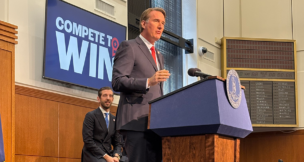
Dominion Energy has set up a staging area at Portsmouth Marine Terminal for the $10.7 billion Coastal Virginia Offshore Wind project. Photo courtesy Port of Virginia

Dominion Energy has set up a staging area at Portsmouth Marine Terminal for the $10.7 billion Coastal Virginia Offshore Wind project. Photo courtesy Port of Virginia
Dominion offshore wind project on track despite hurdles
SUMMARY:
- CVOW will power 660,000 homes by 2026 despite cost hike
- Trump freezes new offshore wind leases; CVOW not impacted
- $233M invested at Port of Virginia for offshore wind staging
- LS GreenLink to build $681M cable plant in Chesapeake
Dominion Energy‘s Coastal Virginia Offshore Wind project is on track to begin powering 660,000 homes in 2026, despite a cost hike and vociferous opposition to wind energy from President Donald Trump.
The Richmond-based Fortune 500 utility earlier this year announced the estimated cost to construct the 2.6-gigawatt project had jumped 9%, from $9.8 billion to $10.7 billion. The price increase is due to higher onshore electrical connection costs and network upgrades assigned by regional electric grid operator PJM. New electric generation resources are assigned costs determined necessary to effectively integrate the resources while safeguarding the electric grid’s reliability and stability.
As a result, customer bills will rise by an average of 43 cents per month. The upsurge is the first increase in CVOW’s budget since Dominion submitted plans to the Virginia State Corporation Commission in 2021.
Meanwhile, within hours of beginning his second term in the Oval Office, Trump issued an executive order freezing new offshore wind leases in federal waters and directing the Department of the Interior to review wind projects’ environmental impacts, as well as the economic effects of intermittent electric generation.
The nation’s largest offshore wind farm currently under construction, CVOW completed the federal approval process during the Biden administration and is not impacted by Trump’s order.
However, the president’s opposition to wind energy could impact Hampton Roads’ bid to become the supply chain hub for the offshore wind energy industry. The Virginia Port Authority, which runs the Port of Virginia, invested $233 million to upgrade 72 acres of the Portsmouth Marine Terminal and 1,500 feet of wharf space to stage offshore wind components, which will be transferred onto installation vessels. New York-based construction firm Skanska completed the project in March.
“Virginia makes a very strong case for being the hub for offshore wind and a myriad of other industries,” says Virginia Department of Energy Director Glenn Davis, who notes Hampton Roads’ status as the East Coast’s deepest port.
Last summer, LS GreenLink USA, a subsidiary of a South Korean undersea cable manufacturer, announced it would build a $681 million plant with 330 employees in Chesapeake to produce submarine electrical cables for offshore wind projects. Construction on the facility was set to begin in late April, with completion slated for the third quarter of 2027. The plant is set to be fully operational by 2028.
“We are still moving forward with the project,” says Patrick Y. Shim, the company’s managing director. However, a planned future investment has been put on hold.
“We hope the Trump administration keeps offshore wind going,” he adds. “We like the American workforce and want to do more in Virginia, but we need a better idea of where everything is heading.”
LS GreenLink USA received a $99 million federal tax credit tied to its job creation and money invested from the U.S. Department of Energy in April 2024 under the Biden administration.
Regardless, construction on CVOW is continuing and was halfway finished as of March, with 78 of 176 turbine foundations and the first offshore substation installed. More than half of the deepwater offshore export cables were installed by the end of October 2024. The process was paused until May to avoid disrupting North Atlantic right whale migration.
Wind turbine tower and blade fabrication are also underway, while production of nacelles, the containers used to house turbine working parts, began in March.
In addition, the first turbines are scheduled to be constructed later this year, says Dominion spokesman Jeremy Slayton.
“We’re confident CVOW will be completed on time,” he says. “Bipartisan leaders agree it has been an economic boon for Virginia. It’s creating thousands of jobs, stimulating billions in economic growth and delivering reliable and affordable energy for our customers.”
Dominion has long promoted the project’s environmental and economic benefits, including reduced carbon emissions and an expected $3 billion in customer fuel savings during its first 10 years in operation. The state’s transition to renewable energy is part of the 2020 Virginia Clean Economy Act that requires Dominion to supply 100% of electricity from renewable power sources by 2045.
In addition, sea trials for Charybdis, the utility’s wind turbine installation vessel and the first built in the U.S., began over the winter. Constructed in Texas, Charybdis will be delivered to Dominion later this year to support CVOW, as well as other offshore wind projects, whose future could now be in doubt under the Trump administration.
Despite offshore wind’s tenuous future, Hampton Roads has an advantage over other areas with similar projects because CVOW falls outside Trump’s executive order, says Katharine Kollins, president of the Southeastern Wind Coalition in Chapel Hill, North Carolina.
While Dominion has not established a timeline to develop its other two ocean leases — the 40,000-acre CVOW-South off Kitty Hawk, North Carolina, and the 176,505-acre section adjacent to CVOW — the permitting process for those projects would not begin during the Trump administration. The utility says those two plots would not be developed until at least the 2030s.
“Long term, the outlook for Hampton Roads is still very good because those projects are not slated to go through the federal permitting process in the next four years,” Kollins says. “Other work can be done, such as surveys, studies and contract negotiations with suppliers, while waiting on the federal permitting process to move forward.”
Nevertheless, she notes that investments require market and regulatory certainties, which ultimately hinge on Trump’s support for offshore wind: “There are many billions of dollars in investment if the president would provide some more certainty. Easily $20 billion of investment is waiting in the wings throughout the country.”
l
















